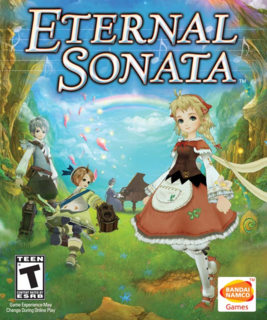A Symphony to Remember
Frederic Chopin is dying. While he lies on his deathbed, he starts to dream of a magical world where every note, song and symphony he ever wrote come to life in the form of characters and locations. The game can be depicted as his inner journey throughout this dream, where a dense plot lies, filled with the classic themes of love, betrayal and death. Since Chopin was a real life character, realism would have been the way to go in terms of art design. But strangely, the only speck of reality in this game lies in slideshows that recount Chopin's Biography, through captioned live-action pictures accompanied by the sound of Chopin's greatest music.
But apart from those memorable sequences, the aesthetic of the game is very anime-like… actually, it's pure anime. Cutscenes have dialogue, action, comedy and directing that follow anime's principles. And they're actually pretty good, filled with cinematic camera angles and great use of soundtrack. Characters are young, cute, act like silly "j-pop" kids, and have the unusual tendency to start digressing about the meaning of life and death. That might've been a downside, but the truth is that the dialogues in these philosophical sequences are sharply written, in the tradition of animes like "Evangelion" or "Ghost in the Shell". However, like the "animes" it resembles, most of the hidden meanings of the narrative only become clear after the game-over screen, and even then, they are never fully explained. Unveiling the hidden meanings of the plot requires some thought, since many actions and dialogues are of an allegorical or metaphorical nature, bursting with spiritual meaning. Art usually lends itself to be open for interpretation, and though games rarely do so, "Eternal Sonata" clearly wants to stand out, and thus become like one of Chopin's melodies: enigmatic and beautiful.
And beautiful is certainly the right word to describe the visuals of "Eternal Sonata". Lush environments, filled with vibrant colors and lighting schemes, merge to form crisp, awe inspiring imagery, with some impressionist references. This aesthetic choice fits perfectly with the game's theme, as Chopin lived roughly around the same time as when the impressionist movement emerged. There's also a rare amount of detail in every game element: buildings' architecture, characters' wardrobe and accessories are portrayed with surgical-like precision and show a great deal of creativity, even by "japanimation" standards. Even the best "Final Fantasies" may look a bit shady when compared to this game's bright color palettes.
"Tri-Crescendo" has been the sound designer of "Tri-Ace" ("Star Ocean" and "Tales" series), and was behind the "Baten Kaitos" games and it shows. Soundtrack (among other things) will feel familiar to those who played any of these games, but, since the subject matter is Chopin, Composer Motoi Sakuraba's music is heavily influenced by his work, which results in one of his best soundtracks so far.
Where "Eternal Sonata" does hit a bad note is in gameplay elements. Hiroya Hatsushiba's creativity appears to have run out after designing the plot and art aspects, something that curiously didn't happen in his previous works ("Baten Kaitos"and "Baten Kaitos II"). The actual game inside "Eternal Sonata" is extremely formulaic, as if it was an afterthought in the creative process. Probably, the designers thought that there was enough innovation in other aspects to risk breaking any more conventions in gameplay. And, looking at the rant "Final Fantasy XII" got for trying to break the mold, maybe they weren't so far off. Action is therefore, business as usual, with towns and dungeon-like areas to explore in the same tiring way as every other J-RPG (talk to very villager, get items in small wooden boxes), and combat is turn-based (with one or two gimmicks that try to cover it up). Battles are somewhat fun (for the first hours anyway) and relatively easy, which is a plus, since that means you don't have to tire yourself too much with the repetition of the attack-attack-heal strategy, which is basically everything you can actually do during combat. On the other hand, dungeons are too elaborate for a game with no map whatsoever, which means consistently exploring every nut and crack of the scenarios, which also means… more dull and insipid combat.
If it wasn't for the blandness of the gameplay aspects of the game, "Eternal Sonata" would probably be one of the greatest RPG's ever made, period. But as it stands, it manages only to achieve one of its goals: create an "artsy" audio-visual interpretation of Chopin's works. The game sees itself as fine art, and fine art it is… it's just not interactive fine art.

